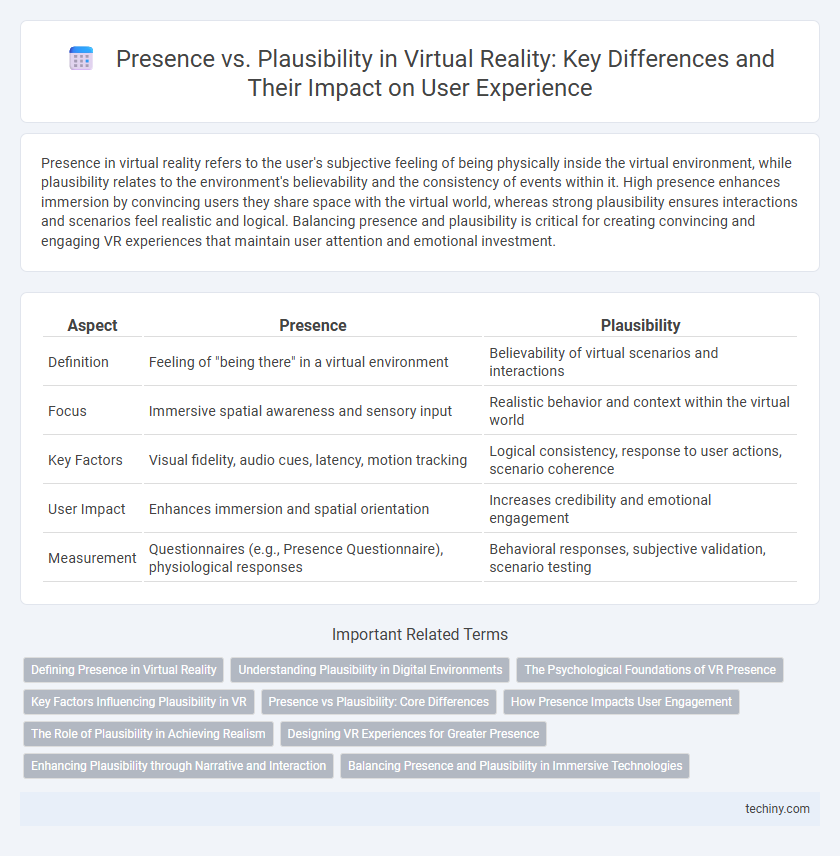Presence in virtual reality refers to the user's subjective feeling of being physically inside the virtual environment, while plausibility relates to the environment's believability and the consistency of events within it. High presence enhances immersion by convincing users they share space with the virtual world, whereas strong plausibility ensures interactions and scenarios feel realistic and logical. Balancing presence and plausibility is critical for creating convincing and engaging VR experiences that maintain user attention and emotional investment.
Table of Comparison
| Aspect | Presence | Plausibility |
|---|---|---|
| Definition | Feeling of "being there" in a virtual environment | Believability of virtual scenarios and interactions |
| Focus | Immersive spatial awareness and sensory input | Realistic behavior and context within the virtual world |
| Key Factors | Visual fidelity, audio cues, latency, motion tracking | Logical consistency, response to user actions, scenario coherence |
| User Impact | Enhances immersion and spatial orientation | Increases credibility and emotional engagement |
| Measurement | Questionnaires (e.g., Presence Questionnaire), physiological responses | Behavioral responses, subjective validation, scenario testing |
Defining Presence in Virtual Reality
Presence in virtual reality refers to the subjective sensation of physically being inside a computer-generated environment, where users perceive the virtual space as real and immersive. This concept is primarily influenced by sensory fidelity, interactivity, and the consistency of spatial cues that align with users' expectations and movements. High levels of presence enhance user engagement and emotional response, differentiating virtual reality experiences from traditional media.
Understanding Plausibility in Digital Environments
Plausibility in digital environments refers to the degree to which users perceive events as credible and responsive within virtual reality, enhancing their emotional engagement and behavioral reactions. Unlike presence, which emphasizes the user's sense of "being there," plausibility focuses on the authenticity and believability of interactions and scenarios. High plausibility requires accurate object behavior, consistent narrative flow, and realistic social dynamics to foster immersive and convincing virtual experiences.
The Psychological Foundations of VR Presence
Presence in virtual reality hinges on the user's psychological immersion, where plausibility--the believable interaction and consistent scenario elements--reinforces the brain's acceptance of the virtual environment as real. Studies highlight that presence is not merely sensory fidelity but the cognitive appraisal of situational credibility, influenced by multi-sensory integration and real-time feedback. Neurophysiological responses such as reduced disbelief and heightened emotional involvement underscore the psychological foundation of VR presence as a critical factor in VR's effectiveness.
Key Factors Influencing Plausibility in VR
Key factors influencing plausibility in virtual reality include realistic interactions, consistent environmental responses, and believable social presence. High-fidelity sensory feedback and intuitive user controls contribute to the sense that virtual events are genuinely occurring. Cognitive congruence between expected and actual outcomes enhances user immersion and trust in the virtual experience.
Presence vs Plausibility: Core Differences
Presence in virtual reality refers to the user's sensation of physically being inside the virtual environment, driven primarily by sensory and spatial coherence. Plausibility centers on the believability of events and interactions within the VR world, relying on narrative consistency and logical cause-effect relationships. Core differences lie in Presence emphasizing sensory immersion, while Plausibility prioritizes cognitive engagement and narrative authenticity.
How Presence Impacts User Engagement
Presence in virtual reality significantly enhances user engagement by creating a convincing sense of being in the virtual environment, which heightens emotional and cognitive involvement. The level of presence correlates with users' ability to interact naturally and stay immersed, reducing distractions from the real world. Strong presence triggers realistic responses and sustained attention, which improves learning, entertainment, and therapeutic outcomes in VR applications.
The Role of Plausibility in Achieving Realism
Plausibility in virtual reality refers to the extent to which users perceive the events and interactions within the simulation as believable and coherent, directly influencing the sense of realism experienced. Unlike presence, which measures the feeling of "being there," plausibility ensures that virtual scenarios behave logically, fostering user trust and immersion. High plausibility reduces cognitive dissonance, enabling seamless user engagement and enhancing overall realism in VR environments.
Designing VR Experiences for Greater Presence
Designing VR experiences to enhance presence involves creating immersive environments that convincingly mimic real-world sensory inputs and interactions. Plausibility is achieved by ensuring virtual scenarios respond dynamically and realistically to user actions, reinforcing the sense of "being there." Optimizing graphical fidelity, spatial audio, and interactive feedback collectively strengthens presence, leading to deeper user engagement and emotional connection.
Enhancing Plausibility through Narrative and Interaction
Enhancing plausibility in virtual reality hinges on crafting immersive narratives that align user expectations with the virtual environment's responses. Interactive elements, such as adaptive storytelling and user-driven decision-making, deepen engagement by creating believable consequences within the simulated world. This synergistic approach strengthens the sense of plausibility, making virtual experiences more compelling and realistic.
Balancing Presence and Plausibility in Immersive Technologies
Balancing presence and plausibility in immersive technologies is crucial for enhancing user experience in virtual reality environments. High presence ensures users feel physically situated within the virtual space, while strong plausibility maintains the believability and logical consistency of events and interactions. Achieving an optimal equilibrium between sensory immersion and meaningful content interactions drives superior engagement and effective simulation outcomes in VR applications.
Presence vs Plausibility Infographic

 techiny.com
techiny.com